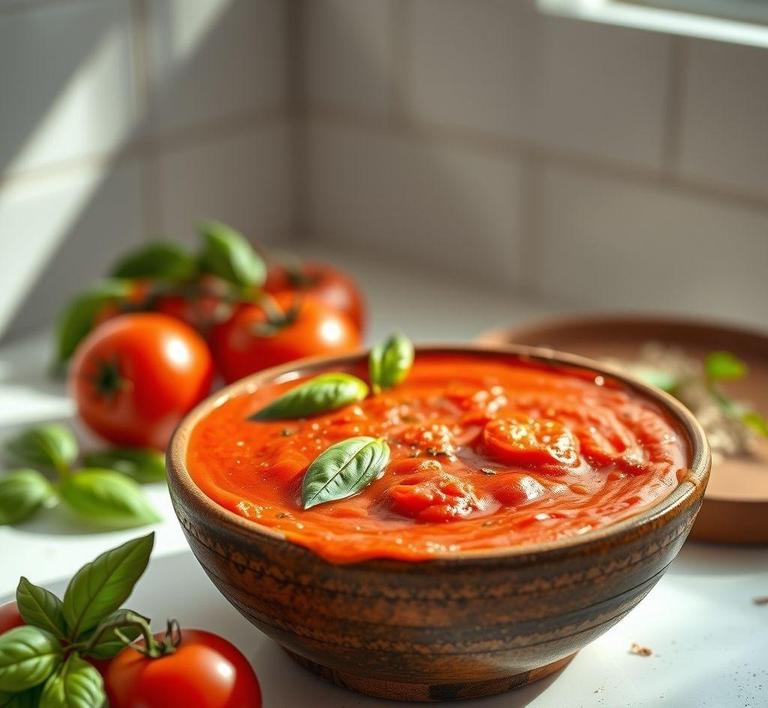If you’re someone who loves making pizza at home, you know that leftover pizza sauce can sometimes be an issue. But don’t toss it just yet-refreezing pizza sauce is totally doable, and it can save you time and reduce waste in the kitchen. Whether you’re trying to preserve that delicious homemade sauce or you’ve bought too much pre-made sauce, knowing how to properly refreeze pizza sauce can be a real game-changer. In this guide, we’ll break down the best ways to store, refreeze, and use your leftover pizza sauce so it stays as fresh and flavorful as the first time you used it!
Can You Refreeze Pizza Sauce?

Absolutely, you can refreeze pizza sauce-but with a few important caveats. Pizza sauce, typically made from tomatoes, herbs, and sometimes a touch of olive oil or garlic, is a relatively resilient ingredient when it comes to freezing. Its high water content and natural acidity help preserve it during the freezing process. However, the real question isn’t just ‘can’ you refreeze it-it’s whether you “should”, and under what conditions.
Refreezing any food, pizza sauce included, introduces a risk of texture degradation, flavor loss, and in rare cases, bacterial growth-if the food was not properly handled during its first thaw. For safety, the general rule of thumb is: if the sauce was thawed in the refrigerator and has not reached room temperature or been left out for more than two hours, it is safe to refreeze. On the other hand, if it sat on the counter or was heated before you changed your mind about using it, refreezing is not advisable.
How To Refreeze Pizza Sauce?
If you’ve thawed too much sauce or simply changed your dinner plans, here’s a step-by-step guide to safely and effectively refreeze your pizza sauce:
-
Assess the Condition:
First, examine the sauce. Has it been left out at room temperature? Was it part of a heated dish or kept chilled? Only sauce that was refrigerated during its thawing window should be considered for refreezing.
-
Cool It Down (If Warmed Slightly):
If the sauce has been slightly warmed but not cooked, ensure it’s quickly cooled down. Place the container in an ice bath or refrigerate it until it reaches a temperature of 40°F (4°C) or below.
-
Use Proper Containers:
Transfer the sauce to an airtight, freezer-safe container or heavy-duty freezer bags. Try to avoid using containers that allow air exposure, as this can accelerate freezer burn and affect flavor. If using bags, lay them flat to freeze-they’ll stack neatly and thaw more quickly later.
-
Label and Date:
Clearly label the container with the refreezing date. This helps you track freshness and ensures it’s used in a timely manner-ideally within one to two months for best quality.
-
Freeze Quickly:
Place the sauce in the coldest part of the freezer. Rapid freezing helps maintain texture and flavor by minimizing the size of ice crystals that form, which can otherwise damage the cell structure of the sauce ingredients.
Quality Impact
While the safety of refreezing properly handled pizza sauce is largely intact, the quality does suffer-especially with repeated freeze-thaw cycles. Tomatoes, the base of most pizza sauces, have a delicate cell structure that can break down after freezing. This often results in a slightly more watery consistency when the sauce is thawed again.
The flavor might also be less vibrant after refreezing, especially if the sauce contains fresh herbs like basil or oregano. These herbs tend to lose their aromatic potency once frozen and refrozen. Similarly, garlic can become more pungent or bitter, and oils may separate slightly, altering the mouthfeel.
That said, quality can often be rescued with a quick reheat and re-seasoning. Simmer the thawed sauce on the stove, allowing excess moisture to evaporate. Add a pinch of salt, sugar, or additional herbs to revive its original complexity. With a little care, the difference may be negligible in a fully assembled pizza.
In the grand scheme of kitchen conundrums, refreezing pizza sauce is one of the more forgiving challenges. Yes, you can safely refreeze pizza sauce-provided it was thawed under controlled conditions and hasn’t been sitting out or heated. While multiple freeze-thaw cycles may cause a noticeable dip in texture and taste, these can often be mitigated with simple culinary adjustments.
When in doubt, consider freezing your sauce in smaller, meal-sized portions from the outset. That way, you only ever need to thaw what you’ll use-and eliminate the need to refreeze altogether. Smart storage and attentive handling are your best allies in preserving both safety and flavor.
So, the next time you find yourself with leftover pizza sauce, feel free to freeze and even refreeze it. Just do so thoughtfully-and your next pizza night will still be as delicious as planned.
Is It Safe To Refreeze Pizza Sauce?
Pizza sauce-rich, tangy, and herby-is often a staple in both home kitchens and pizzerias. When it comes to storing it safely, the question of whether it’s okay to refreeze pizza sauce after it’s been thawed is a valid concern. In short: yes, it is generally safe to refreeze pizza sauce-but only under specific conditions that maintain food safety and preserve its quality.
Pizza sauce, like most tomato-based sauces, is relatively low-risk in terms of microbial growth, especially when compared to meat or dairy-heavy foods. Tomatoes are acidic, and this acidity helps inhibit the proliferation of harmful bacteria. However, that doesn’t mean it’s immune to spoilage or contamination. Refreezing pizza sauce is only safe if it was thawed in the refrigerator and has not been left out at room temperature for more than two hours (or one hour if the room temperature is above 90°F/32°C). If these conditions are met, the sauce can be safely returned to the freezer.
The catch? Repeated freezing and thawing cycles can impact both the texture and flavor. Ice crystals formed during freezing can rupture the cellular structure of the tomatoes, leading to a more watery consistency when thawed again. Herbs and spices may also lose their pungency over time, so while the sauce remains safe, the sensory experience may decline.
Signs That Pizza Sauce Should Not Be Refrozen
To avoid foodborne illness and ensure you’re working with quality ingredients, it’s crucial to recognize the warning signs that your pizza sauce has gone bad or is unsafe to refreeze. Here are the most telling indicators:
- Off or Sour Odor: Fresh pizza sauce should smell like tomatoes, garlic, and herbs. A sour, fermented, or musty odor is a sign of microbial activity, and the sauce should be discarded.
- Mold Growth: If you see mold-even a small speck-toss the entire container. Mold spores can penetrate beyond the visible surface, especially in semi-liquid foods like sauces.
- Bubbling or Gassy Texture: If the sauce seems to bubble or fizz without being heated, it could be a sign of fermentation, which indicates spoilage.
- Color Changes: A significant darkening or separation of liquids may signal degradation. While some separation is normal after freezing, a brownish or grey hue is a red flag.
- Previously Improper Handling: If the sauce was previously thawed on the countertop or left in the danger zone (40°F-140°F) for too long, it’s no longer safe to refreeze.
Common Refreezing Mistakes
Even the most well-intentioned home chefs make mistakes when it comes to freezing and refreezing food. Here are some of the most common missteps when it comes to pizza sauce:
- Thawing at Room Temperature: Letting sauce thaw on the counter invites bacteria to multiply quickly. Always thaw in the refrigerator or use a microwave if you plan to use it immediately.
- Refreezing Sauce That’s Been Left Out: If the sauce was forgotten and left out for a few hours, it’s safer to discard it rather than risk foodborne illness.
- Using the Same Container Repeatedly: Opening and refreezing from the same large container increases exposure to bacteria and degrades quality faster. Divide the sauce into smaller portions instead.
- Not Labeling the Sauce: Without a date, it’s hard to track how long the sauce has been frozen. Aim to use frozen pizza sauce within three to four months for the best quality.
Tips And Tricks
To get the most out of your pizza sauce-and to minimize waste-here are some expert tips and practical tricks:
- Portion Control: Freeze sauce in small, usable portions. Ice cube trays work wonderfully for this. Once frozen, pop the cubes out and store them in a resealable freezer bag. This way, you only thaw what you need.
- Use Airtight Containers: Minimize air exposure by using freezer-safe bags or containers with tight seals. Pressing a layer of plastic wrap directly onto the surface of the sauce can also help prevent freezer burn.
- Label Everything: Write the date and portion size on each container. This simple step keeps your freezer organized and your food safe.
- Cool Before Freezing: Let the sauce cool completely before putting it in the freezer to prevent ice crystals and condensation, which can affect texture.
- Add Freshness After Thawing: If the thawed sauce tastes a bit dull, revive it with a sprinkle of fresh herbs, a splash of olive oil, or a pinch of salt and pepper.
Conclusion
Pizza sauce, with its luscious tomato base and aromatic herbs, deserves proper care and handling to preserve its integrity and safety. Refreezing is indeed a viable option-provided that the sauce was handled safely, shows no signs of spoilage, and is refrozen promptly after proper thawing. Avoid common mistakes by staying attentive to time, temperature, and container hygiene.
With smart practices like portioning, labeling, and quality checks, you can enjoy the convenience of homemade or store-bought pizza sauce whenever you crave it-without compromising flavor or safety. So go ahead, prep a little extra and freeze it with confidence. Your future self (and your future pizza nights) will thank you.

